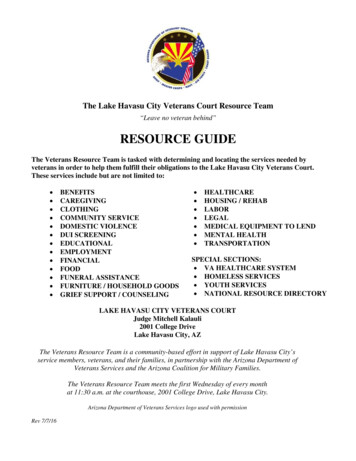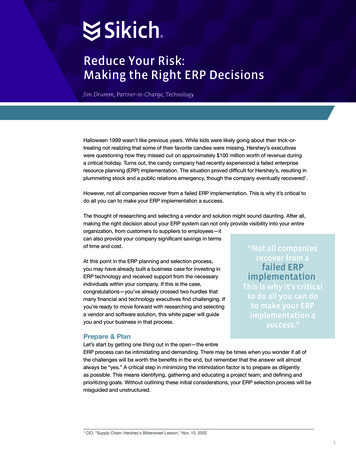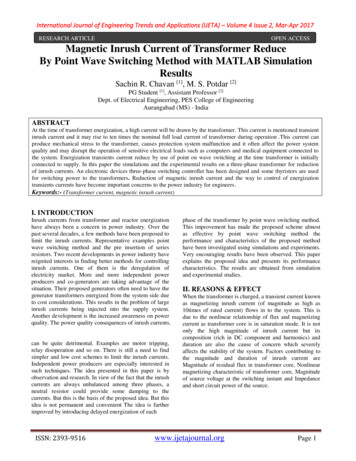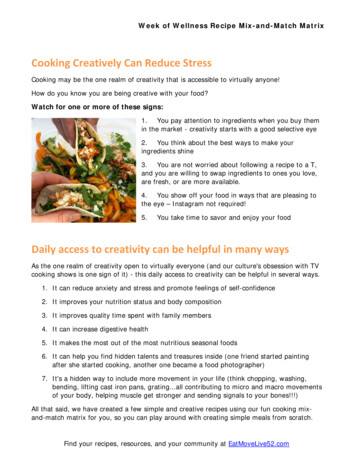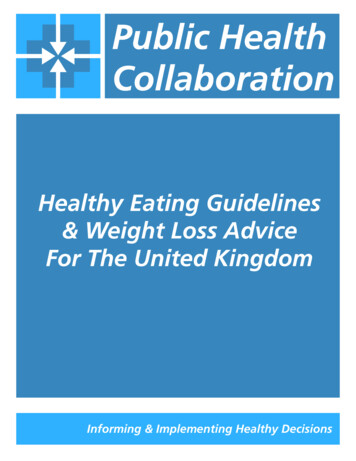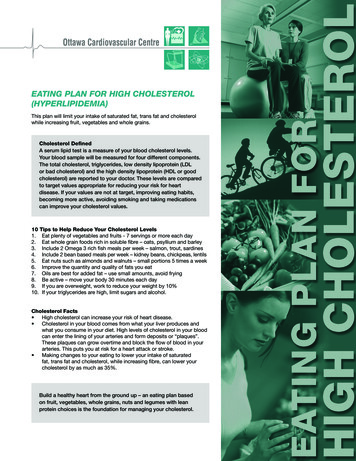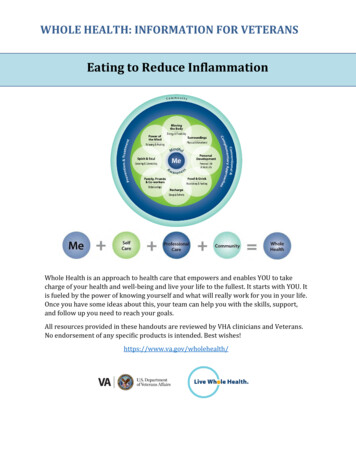
Transcription
WHOLE HEALTH: INFORMATION FOR VETERANSEating to Reduce InflammationWhole Health is an approach to health care that empowers and enables YOU to takecharge of your health and well-being and live your life to the fullest. It starts with YOU. Itis fueled by the power of knowing yourself and what will really work for you in your life.Once you have some ideas about this, your team can help you with the skills, support,and follow up you need to reach your goals.All resources provided in these handouts are reviewed by VHA clinicians and Veterans.No endorsement of any specific products is intended. Best wishes!https://www.va.gov/wholehealth/
Eating to Reduce InflammationEating to Reduce InflammationWhat is inflammation?Inflammation is one of the body’s ways of protecting itself. It helps fight off infections,increases blood flow to places where healing is needed, and signals us, through pain, thatsomething is wrong. But if inflammation levels are too high, or if a person stays in aninflamed state for too long (has chronic inflammation), it can lead to disease.What diseases are associated with unhealthy inflammation?Many diseases are linked to inflammation. These are often chronic (long-lasting) diseases,which can be very hard to treat. Here are some examples:1,2 Alzheimer’s disease Asthma Autoimmune diseases (diseases where the body is attacked by its own immunesystem). These include rheumatoid arthritis, scleroderma, and lupus. Cancer Chronic obstructive lung disease, also called COPD (emphysema and bronchitis) Chronic pain (e.g. back pain, neck pain, headaches, arthritis) Depression Heart disease Inflammatory bowel disease (Crohn’s or ulcerative colitis) Type 2 diabetes ObesityThere are many others as well. What they all have in common is that they can often beprevented or reduced if you focus on eating some foods and not eating others. This way ofeating is often called the Anti-Inflammatory Diet. Unlike other diets, an anti-inflammatorydiet is not meant to be a diet for losing weight. It supports your health in other ways.How do I eat an anti-inflammatory diet?It is thought that over 60% of all chronic disease could be prevented if people ate a healthydiet.3 What does that diet look like? Some of the most important parts of it are listedbelow.4 Choose any one to start out. Over time, you can add others at a pace that works foryou.The Anti-Inflammatory Diet: Top Ten Suggestions1. Pay attention to proteins. If you get most of your proteins from plants like beans,whole grains, and nuts, your levels of inflammation will be lower. If you eat red meat, itis best to eat grass-fed meat or wild game rather than grain-fed beef.5 Wild-caught (asopposed to farmed) fish can be a great source of protein. As journalist Michael Pollansays in his book Food Rules, “The fewer the feet, the better the meat.”62. Eat more fiber. Fiber, which is a form of carbohydrate, lowers inflammation.7 Readfood labels. Different groups suggest different daily amounts, but try for the following: Women 19-50 years old: 25 grams dailyPage 2 of 7
Eating to Reduce Inflammation Men 19-50: 38 grams daily Women over 50: 21 grams daily Men over 50: 30 grams dailyGood sources of fiber include whole grains, oatmeal, nuts, berries, beans, vegetables,brown rice, and popcorn. Potato skins have a lot of fiber. If you don’t already eat muchfiber, increase your intake of these foods slowly to avoid bowel discomfort.3. Eat your vegetables and fruits. When it comes to ideas for healthier eating, eatingmore fruits and vegetables is usually at the top of the list. In addition to their manyother benefits, vegetables and fruits reduce inflammation. Berries and cherries areespecially good options. Fruit juice is not usually a good choice because it is high insugars and low in fiber. Making your own smoothies is a good idea. Choose darkcolored produce that is many different colors. Plants get their colors fromphytonutrients, helpful compounds that are anti-inflammatory. Strive for a minimumof 5 cups of vegetables and fruits per day. If you have diabetes or pre-diabetes,emphasize non-starchy vegetables over fruits.4. Use more anti-inflammatory herbs and spices.8,9 A 2012 study found that some ofthe best anti-inflammatory spices to eat, in order, are paprika, rosemary, ginger,turmeric, sage, and cumin. An earlier study looked at other chemical properties ofspices and found that cloves, ground Jamaican allspice, cinnamon, sage, marjoram, andtarragon are also great choices.Guidelines 5-8 are related to fats. In the body, different types of fats are processed in differentways, which can either increase or decrease inflammation.5. Avoid trans-fats. Trans-fats, which are added to foods to increase their shelf life, canadd to the body’s inflammation. Avoid foods that have labels saying they have “partiallyhydrogenated” oils. Foods that often have trans-fats include baked goods (e.g. cakes,piecrusts, frozen pizza, and cookies) and fried foods (e.g. donuts, fries).6. Limit saturated fats. Most (not all) saturated fats also promote inflammation. Thesefats mostly come from animal sources such as meats (lamb, pork, chicken with skin,fatty beef), and dairy products like milk, cheese, cream, and butter. If you eat meat, agood general rule is to try to eat white meats, fish and other seafood. Saturated fatsfrom plants (coconut and palm kernel oils) may not be as much of a problem.7. Balance omega-6’s and omega-3’s. You may have heard about essential fatty acids.These are types of polyunsaturated fats that your body can’t make on its own. You haveto get them from your diet. You need both omega-6 and omega-3 fats for your body towork properly, but they need to be in the right balance. The problem is that eating highamounts of omega-6 fats compared to omega-3’s can increase inflammation.Unfortunately, that is exactly what most Americans do. Our ancestors ate twice asmuch omega-6 fat as omega-3. Nowadays, most Americans eat 14 to 25 times as muchomega-6.Page 3 of 7
Eating to Reduce InflammationOmega-6’s come from plant oils like corn oil, soybean oil, and sunflower oil, as well asnuts and seeds. Omega-3’s are found in fatty fish like salmon, tuna, and mackerel. Try toeat at least two servings of fish (3-4 ounces each) weekly. Fish oil supplements arewidely available. A usual dose is 1000-2000 mg per day. If you are taking bloodthinners, talk to your doctor before you start taking fish oil. Omega 3’s are also found inwhole grains, walnuts, and green leafy vegetables. Eating a Mediterranean diet will giveyou a much healthier balance of omega-6’s and omega 3’s than the average Americandiet. For more information, reference the Whole Health handout “How to Eat aMediterranean Diet.”8. Eat monounsaturated fats. There are also monounsaturated fats. One of these, oliveoil, is known to reduce inflammation, blood pressure, bad cholesterol, and blood sugarlevels. Other sources of this type of fat are canola, peanut, safflower, and sesame oils.Avocados are another good source.Some experts suggest you get ¼ of your fat from saturated fats, ¼ frompolyunsaturated, and ½ from monounsaturated. Many diets recommend that total fatsadd up to about ⅓ of all the calories you eat.10 You have to explore what works best foryou.9. Eat some dark chocolate.11 Most people like this suggestion. To help withinflammation, dark chocolate should be at least 70% cocoa mass. The cocoa percentagewill be on the label. One and a half ounces daily decreases inflammation and alsolowers blood pressure.10. If you choose to drink alcohol, choose red wine. Red wine is known to decreaseinflammation.12 Of course, don’t take up drinking to get this benefit. One study foundthat drinking white wine and cooking with olive oil worked together to lowerinflammation as well.13 Other beverages, like grape juice,14 have been found to havesome benefits, too, though we need more studies to see how different beveragescompare. Remember, though, that even one drink of alcohol a day can increase risk ofbreast cancer.15Can anything besides what I eat lower inflammation?In addition to watching what you eat and drink, focusing on other areas of self-care can alsohelp lower inflammation. For example: Working the body reduces chronic inflammation.16,17 Stress raises inflammation in the body,18 so do your best to keep your stress at ahealthy level. There are many ways to manage stress, such as breathing exercisesand meditation. These are outlined in the Power of Mind handouts. Depression is linked to more inflammation too.19 Explore ways to support goodmental and emotional health. Getting enough sleep helps to keep inflammation under control.20 Some studies show that having healthy relationships with others lowersinflammation.21 Being a spiritual/religious person also seems to be linked to less inflammation.22Page 4 of 7
Eating to Reduce InflammationA Quick Guide to Eating and InflammationINCREASEDECREASEFruits & VegetablesProteins Red: berries, cherries, peppers Orange-Yellow: Sweet potato,pineapple, yellow pepper, squash,peaches Grain-fed beef Processed meats (lunch/deli meats,hot dogs, bacon, sausage)Trans-fats Green: Dark leafy greens, broccoli,cabbage, green beans, Brussels sprouts Partially hydrogenated oils Baked goods (cakes, pie crusts, frozenpizza, cookies) Blue/Purple/Black: blueberries,blackberries, grapes, eggplant, olives,plums, purple cabbage Fried foods (donuts, fries)Saturated FatsFiber Meats (lamb, pork, fatty beefchicken with skin) Whole grains, oatmeal, bran cereal,nuts, berries, beans, brown rice,popcorn, potato skins Dairy products(milk, cheese, cream, butter) Vegetables Fruits Fruit juiceProteins Plant-based (beans, grains, nuts, seeds) Grass-fed or wild meat and fishHerbs & Spices Paprika, rosemary, ginger, turmeric,sage, cumin, cloves, Jamaican allspice,cinnamon, marjoram, tarragon, greenand black teaOmega-3’s Fatty fish (salmon, tuna, mackerel) Fish oil Whole grains, walnuts, greenvegetables Eat more Omega-3’s than Omega-6’sMonounsaturated Fats Oils (olive, canola, peanut, safflower,sesame) AvocadosDesserts /Snacks Dark chocolate (70% of cocoa or more)Page 5 of 7
Eating to Reduce InflammationFor you to consider: After reading this handout, are you concerned about inflammation? If so, whatconcerns you?Do you want to use food and drink to reduce the amount of inflammation in yourbody? If yes, which of the Top 10 Suggestions will you focus on first?Are there other areas of self-care you will focus on to reduce inflammation? (Referto the ideas on the bottom of page 3). What goal will you set for yourself?The information in this handout is general. Please work with your health care team touse the information in the best way possible to promote your health and happiness.For more information:ORGANIZATIONVeterans HealthAdministrationRESOURCESA variety of WholeHealth handouts onhealthy n-handouts/index.aspThis handout was written for the Veterans Health Administration (VHA) by J. Adam Rindfleisch, MPhil,MD, Associate Professor, Medical Director of the Integrative Health Program, University of WisconsinDepartment of Family Medicine and Community Health. The handout was reviewed and edited byVeterans and VHA subject matter experts.References1. Leonard BE. Pain, Depression and Inflammation: Are Interconnected Causative FactorsInvolved? Mod Trends Pharmacopsychiatri. 2015;30:22-35. doi: 10.1159/000435930.2. Sharp S. The anti-inflammatory diet: Clinical tool. Whole Health: Change the Conversation. A jointproject of the University of Wisconsin-Madison Integrative Medicine Program, Pacific Institutefor Research and Evaluation, and the U.S. Department of Veterans Affairs Office of PatientCentered Care and Cultural Transformation. 2014.3. Willett WC. The Mediterranean diet: science and practice. Public Health Nutr. 2006;9(1a):105110.4. Galland L. Diet and inflammation. Nutr Clin Pract. 2010;25(6):634-640. doi:10.1177/0884533610385703.5. 10 ridiculously healthy foods for your heart. Prevention for-heart-health/slide/5. Accessed March 10, 2016.6. Pollan M. Food Rules: An Eater's Manual. New York, NY: Penguin; 2009.7. Ma Y, Griffith JA, Chasan-Taber L, et al. Association between dietary fiber and serum C-reactiveprotein. Am J Clin Nutr. 2006;83(4):760-766.8. Percival SS, Vanden Heuvel JP, Nieves CJ, Montero C, Migliaccio AJ, Meadors J. Bioavailability ofherbs and spices in humans as determined by ex vivo inflammatory suppression and DNAstrand breaks. Journal of the American College of Nutrition. 2012;31(4):288-294.9. Dearlove RP, Greenspan P, Hartle DK, Swanson RB, Hargrove JL. Inhibition of protein glycationby extracts of culinary herbs and spices. J Med Food. 2008;11(2):275-281. doi:10.1089/jmf.2007.536.10. Institute of Medicine Panel on Macronutrients, Institute of Medicine Standing Committee on theScientific Evaluation of Dietary Reference Intakes. Dietary Reference Intakes for Energy,Carbohydrate, Fiber, Fat, Fatty Acids, Cholesterol, Protein, and Amino Acids. Washington, D.C.:National Academies Press; 2005.Page 6 of 7
Eating to Reduce Inflammation11. Higginbotham E, Taub PR. Cardiovascular Benefits of Dark Chocolate? Curr Treat OptionsCardiovasc Med. 2015;17(12):54. doi: 10.1007/s11936-015-0419-5.12. Torres A, Cachofeiro V, Millán J, et al. Red wine intake but not other alcoholic beveragesincreases total antioxidant capacity and improves pro-inflammatory profile after an oral fat dietin healthy volunteers. Rev Clin Esp. 2015;215(9):486-494. doi: 10.1016/j.rce.2015.07.002.13. Migliori M, Panichi V, de la Torre R, et al. Anti-inflammatory effect of white wine in CKD patientsand healthy volunteers. Blood Purif. 2015;39(1-3):218-223. doi: 10.1159/000371570.14. Khadem-Ansari MH, Rasmi Y, Ramezani F. Effects of red grape juice consumption on highdensity lipoprotein-cholesterol, apolipoprotein AI, apolipoprotein B and homocysteine inhealthy human volunteers. Open Biochem J. 2010;4:96-99. doi:10.2174/1874091x01004010096.15. Choi YJ, Myung SK, Lee JH. Light Alcohol Drinking and Risk of Cancer: A Meta-Analysis of CohortStudies. Cancer Res Treat. 2018;50(2):474-487. doi: 10.4143/crt.2017.094.16. Teixeira-Lemos E, Nunes S, Teixeira F, Reis F. Regular physical exercise training assists inpreventing type 2 diabetes development: focus on its antioxidant and anti-inflammatoryproperties. Cardiovasc Diabetol. 2011;10:12. doi: 10.1186/1475-2840-10-12.17. Lira FS, Rosa Neto JC, Antunes BM, Fernandes RA. The relationship between inflammation,dyslipidemia and physical exercise: from the epidemiological to molecular approach. CurrDiabetes Rev. 2014;10(6):391-396.18. Lu XT, Zhao YX, Zhang Y, Jiang F. Psychological stress, vascular inflammation, andatherogenesis: potential roles of circulating cytokines. J Cardiovasc Pharmacol. 2013;62(1):6-12.doi: 10.1097/FJC.0b013e3182858fac.19. Kiecolt-Glaser JK, Derry HM, Fagundes CP. Inflammation: depression fans the flames and feastson the heat. Am J Psychiatry. 2015;172(11):1075-1091. doi: 10.1176/appi.ajp.2015.15020152.20. Solarz DE, Mullington JM, Meier-Ewert HK. Sleep, inflammation and cardiovascular disease.Front Biosci (Elite Ed). 2012;4:2490-2501.21. Yang YC, Li T, Frenk SM. Social network ties and inflammation in U.S. adults with cancer.Biodemography Soc Biol. 2014;60(1):21-37. doi: 10.1080/19485565.2014.899452.22. Hybels CF, George LK, Blazer DG, Pieper CF, Cohen HJ, Koenig HG. Inflammation and Coagulationas Mediators in the Relationships Between Religious Attendance and Functional Limitations inOlder Adults. J Aging Health. 2014;26(4):679-697. doi: 10.1177/0898264314527479.6/15/2020Page 7 of 7
Jul 25, 2019 · Eating to Reduce Inflammation Whole Health is an approach to health care that empowers and enables YOU to take charge of your health and well-being and live your life to the fullest. . eating is often called the Anti-Inflammatory Diet. Unlike other diets, an anti-inflammatory diet is not meant to be a
